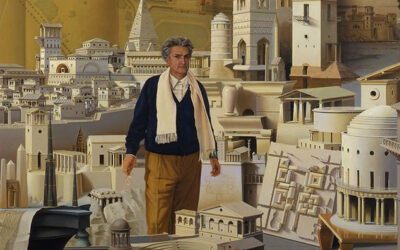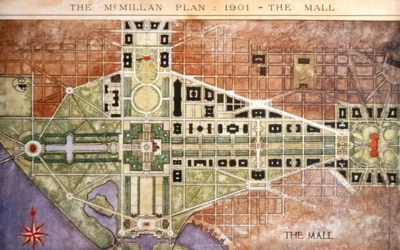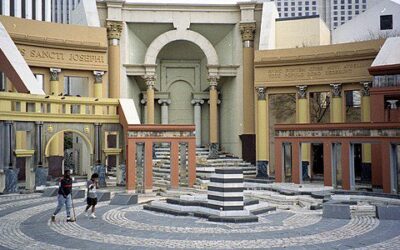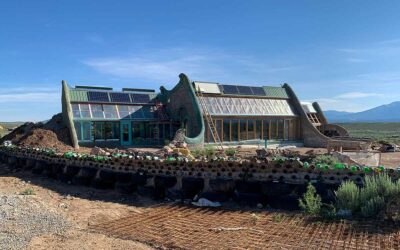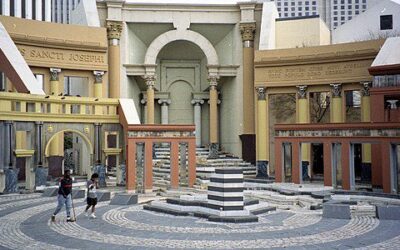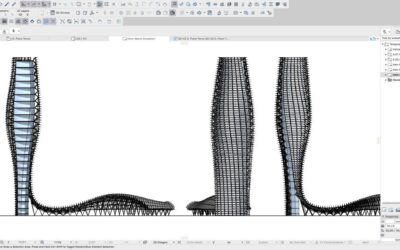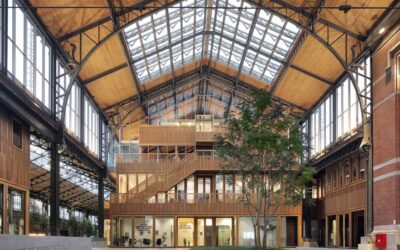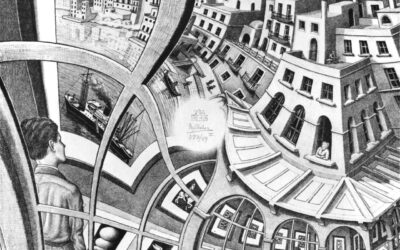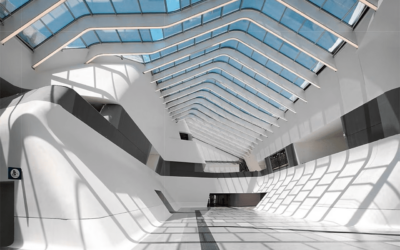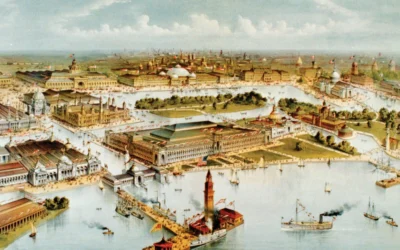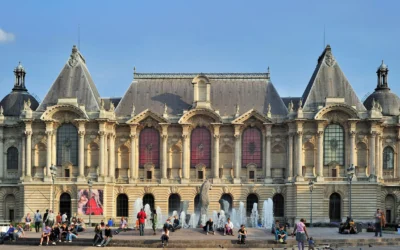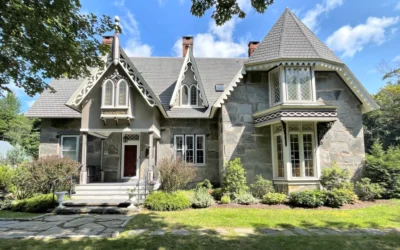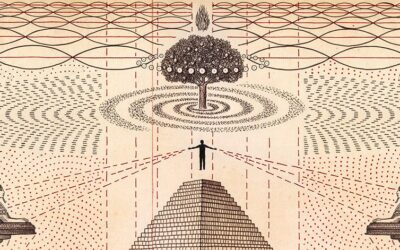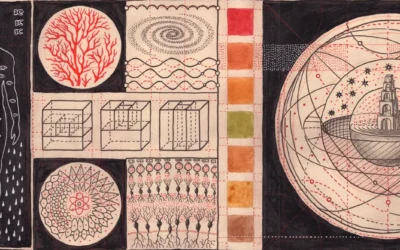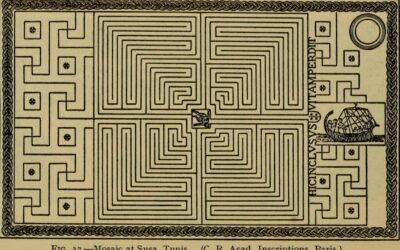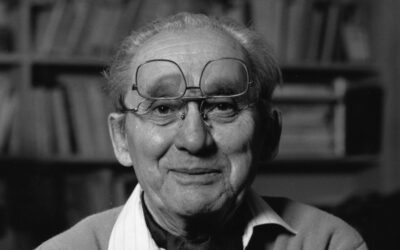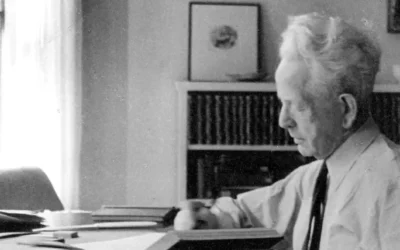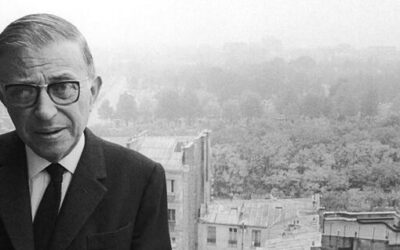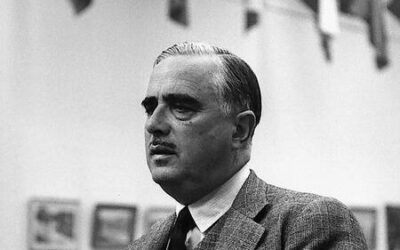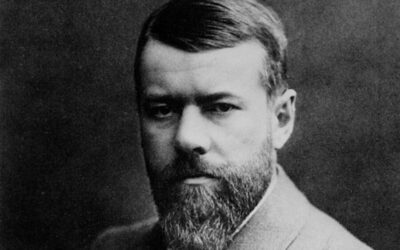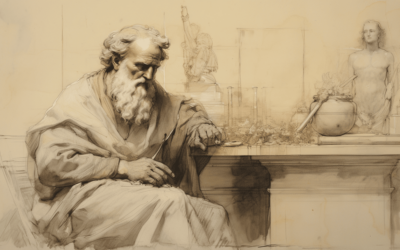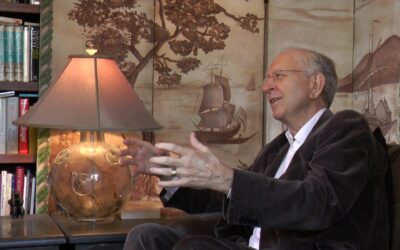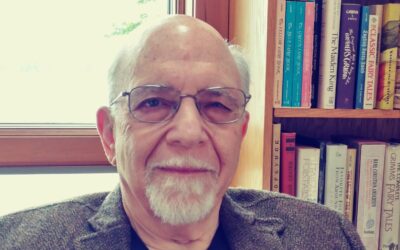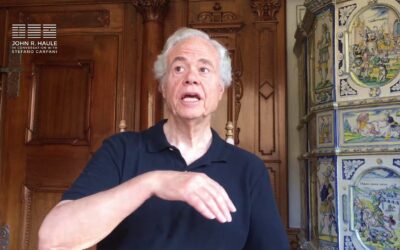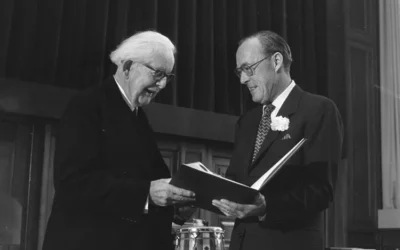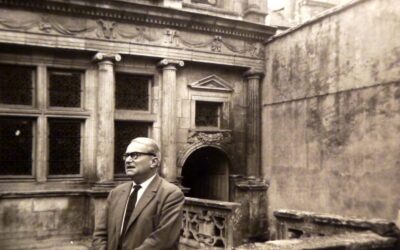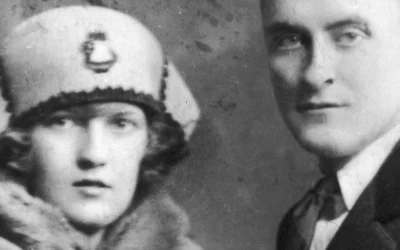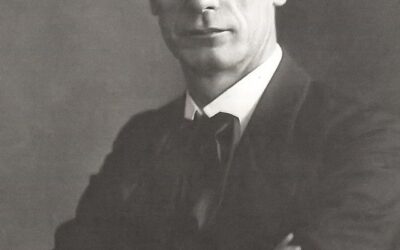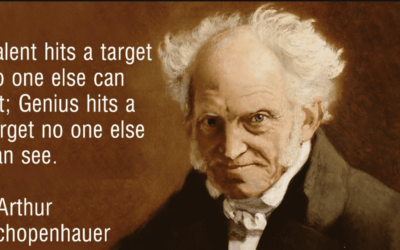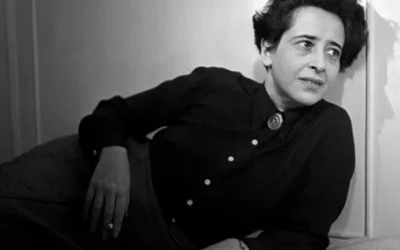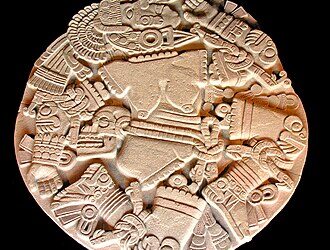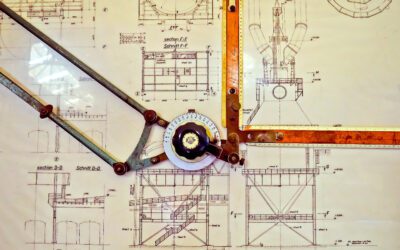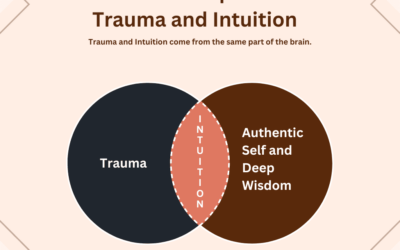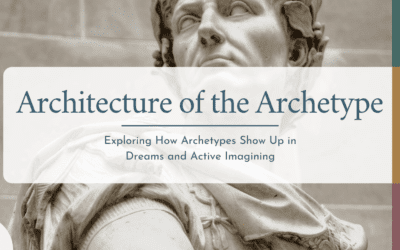All experience is past by definition. Tradition is transmission of past experience which has become knowledge and know-how. Thus, we can with reason conclude that without tradition, there can be no language, no philosophy, no science, no technique, art, or industry. Why should architecture be an exception? - Leon Krier form Howard Roark: Defended Against His Admirers The Traditionalist Architect Who Built for the Future Leon Krier passed away this week, leaving behind a legacy that fundamentally challenged how we...
The Psychology of Architecture: How Our Built Environment Shapes Mind, Behavior, and Healing
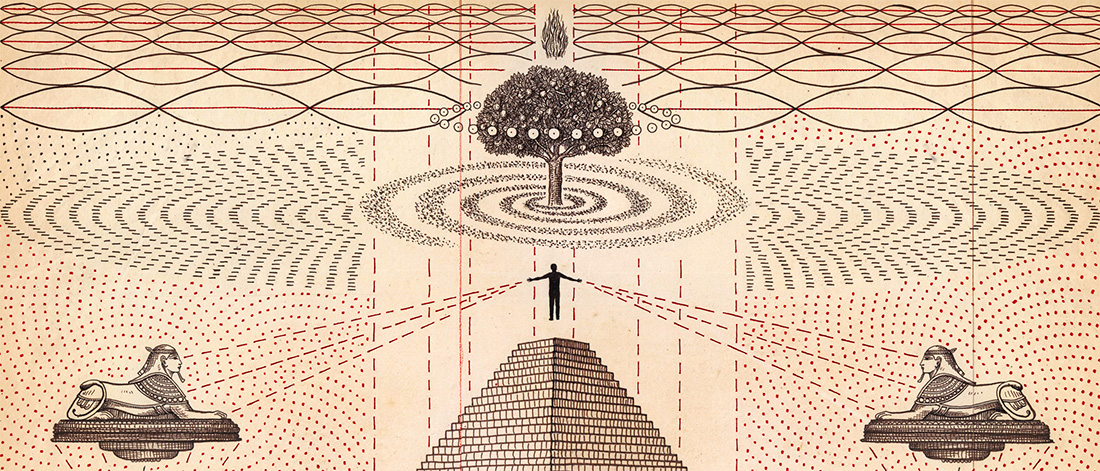
Exploring how design choices influence psychological experience, from therapeutic office layouts to home environments that support mental wellness
The spaces we inhabit are far more than mere shelter—they are active participants in shaping our thoughts, emotions, behaviors, and overall mental health. From the moment we wake up in our bedrooms to the environments where we work, learn, and seek healing, architecture and design exert a profound psychological influence that operates largely below the threshold of conscious awareness.
Psychology of Buildings and Architecture represents a fascinating intersection where environmental psychology meets therapeutic practice, revealing how thoughtful design can either support or hinder human flourishing.
The Foundations of Environmental Psychology
Environmental psychology emerged in the mid-20th century as researchers began to systematically study the relationship between built environments and human behavior. This field recognizes that our psychological well-being is intricately connected to the physical spaces we occupy, challenging the traditional medical model that often treats mental health as purely internal phenomenon.
The Neurological Basis of Space: Our brains are evolutionarily wired to respond to environmental cues. The neuroscience of space perception shows that our nervous system continuously scans our surroundings for safety, beauty, and functionality. This ancient survival mechanism means that architectural elements—from ceiling height to lighting quality—directly influence our stress levels, creativity, and social behavior.
Archetypal Responses to Built Form: Leon Krier and Carl Jung’s insights into architectural archetypes reveal that humans have deep, instinctual reactions to certain shapes, proportions, and spatial arrangements. These archetypal responses suggest that effective design taps into universal patterns that resonate with our collective unconscious, creating spaces that feel intuitively “right” across cultures and historical periods.
How Architecture Influences Mental Health
The built environment affects mental health through multiple interconnected pathways:
Direct Physiological Effects
Lighting and Circadian Rhythms: Natural light exposure significantly impacts mood, sleep cycles, and seasonal affective disorder. Holistic approaches to mental health increasingly recognize that environmental factors like lighting quality must be addressed alongside traditional therapeutic interventions.
Air Quality and Cognitive Function: Poor ventilation, toxic materials, and environmental pollutants can contribute to anxiety, depression, and cognitive fog—symptoms that may not respond to therapy alone without addressing the underlying environmental causes.
Noise and Stress Response: Chronic exposure to noise pollution elevates cortisol levels and can trigger trauma responses, particularly in individuals with PTSD or anxiety disorders.
Psychological and Social Impacts
Spatial Arrangement and Social Interaction: Design psychology research demonstrates that furniture arrangement, room layout, and architectural features significantly influence how people interact, communicate, and form relationships.
Privacy and Autonomy: The ability to control one’s environment—including privacy levels, lighting, temperature, and territorial boundaries—directly impacts psychological well-being and stress levels.
Biophilic Design and Nature Connection: Incorporating natural elements into built environments reduces stress, improves cognitive function, and supports emotional regulation. This aligns with holistic healing approaches that recognize humans’ innate need for nature connection.
The Psychology of Different Architectural Styles
Architecture embodies the psychological and cultural values of its era, creating environments that can either support or conflict with human psychological needs:
Modernist Architecture and the Psyche
The psychology of modernist architecture reveals both liberating and alienating aspects of 20th-century design. While modernist principles of clean lines, open spaces, and functional efficiency can create clarity and focus, the stark minimalism and separation from nature can also contribute to feelings of isolation and disconnection.
The Shadow of Modernism: The repressed elements of modernist design—its denial of ornament, historical continuity, and human scale—often manifest as psychological discomfort in users. This has led to the recognition that purely functional design may neglect essential human psychological needs for beauty, meaning, and connection.
Romantic and Traditional Architecture
Romantic architecture’s emphasis on emotion and nature represents a design philosophy that actively seeks to evoke psychological responses. Features like irregular forms, natural materials, and integration with landscape create environments that feel more psychologically nourishing than purely rational designs.
New Urbanism and Community Psychology: Leon Krier’s critique of modernist planning highlighted how suburban sprawl and functional zoning contribute to social isolation and mental health challenges. His advocacy for walkable, mixed-use communities reflects an understanding that architectural design is inherently political and psychological.
Contemporary Responses to Psychological Needs
Modern architects increasingly recognize the importance of designing for psychological well-being:
Biophilic Design: Incorporating plants, natural light, water features, and organic forms helps satisfy humanity’s innate biophilia, reducing stress and supporting mental health.
Trauma-Informed Design: Understanding how built environments can trigger or soothe trauma responses has led to new approaches in therapeutic spaces, schools, and healthcare facilities.
Neuroarchitecture: This emerging field applies neuroscience research to architectural design, creating environments optimized for specific psychological and cognitive outcomes.
The Therapeutic Environment: Design for Healing
The design of therapeutic spaces represents one of the most intentional applications of environmental psychology:
Elements of Healing Spaces
Therapeutic Office Design: How therapeutic spaces support healing involves careful attention to factors like:
- Furniture arrangement that supports both intimacy and appropriate boundaries
- Lighting that feels warm and inviting rather than clinical
- Color palettes that promote calm and openness
- Natural elements that reduce stress and anxiety
- Sound management that ensures privacy and reduces distractions
Trauma-Informed Environments: For individuals with complex trauma and PTSD, environmental triggers can significantly impact treatment outcomes. Trauma-informed design considers:
- Multiple exit routes to prevent feelings of being trapped
- Controllable lighting and temperature
- Soft, natural textures rather than institutional materials
- Clear sightlines that allow clients to monitor their environment
- Spaces that feel residential rather than medical
Cultural and Regional Considerations
Birmingham’s architectural heritage and design traditions influence how local residents experience different environments. Southern design elements like covered porches, natural materials, and connection to outdoor spaces can provide psychological comfort that supports therapeutic work.
Community-Centered Design: Effective therapeutic environments must consider the cultural background and community context of their users. Taproot Therapy Collective’s approach demonstrates how integrative therapy practices can honor regional design traditions while incorporating evidence-based environmental psychology principles.
The Home Environment and Mental Health
Our living spaces profoundly impact daily mental health and well-being:
Psychological Functions of Home
Safety and Security: The home serves as our primary refuge from external stressors. When home environments feel chaotic, unsafe, or uncomfortable, this fundamental psychological need goes unmet.
Identity Expression: The psychology of design reveals how our spaces reflect our minds. The objects, colors, and arrangements we choose in our homes both express and shape our sense of self.
Restoration and Recovery: Home environments must support the nervous system’s need for downregulation after daily stressors. This is particularly important for individuals managing anxiety, depression, or trauma.
Creating Psychologically Supportive Homes
Clutter and Mental Clarity: Research consistently shows that cluttered environments contribute to elevated cortisol levels and difficulty concentrating. The psychological benefits of organization extend beyond mere aesthetics to include improved emotional regulation and stress management.
Natural Light and Mood: Homes with abundant natural light support circadian rhythm regulation and mood stability. This is particularly important for individuals with seasonal affective disorder or depression.
Personalization and Control: The ability to modify and personalize one’s living space supports psychological well-being by providing a sense of agency and environmental control.
Urban Planning and Community Mental Health
The broader built environment—from neighborhood design to city planning—significantly impacts community mental health:
Walkability and Social Connection
Community Design and Mental Health: Environmental factors affecting mental wellness include neighborhood walkability, access to green spaces, and opportunities for social interaction. Car-dependent suburban design can contribute to isolation and depression, while walkable communities with mixed-use development support mental health through increased social connection and physical activity.
Green Spaces and Psychological Restoration: Urban parks, tree-lined streets, and accessible natural areas provide opportunities for stress reduction and nature-based healing approaches that complement traditional therapy.
Environmental Justice and Mental Health
Toxic Environments and Psychological Impact: Low-income communities often bear disproportionate exposure to environmental hazards—poor air quality, noise pollution, lack of green space—that contribute to higher rates of anxiety, depression, and other mental health challenges.
Design Equity: Ensuring that all communities have access to psychologically supportive built environments is both a public health and social justice issue.
The Future of Psychologically-Informed Design
Emerging trends in architecture and design increasingly prioritize psychological well-being:
Technology Integration
Smart Buildings and Responsive Environments: Advanced building systems can now adjust lighting, temperature, and even scent based on occupant stress levels and circadian rhythms, creating environments that actively support mental health.
Virtual and Augmented Reality: These technologies allow architects to test psychological responses to designs before construction, enabling more evidence-based environmental psychology applications.
Post-Pandemic Design Insights
Flexibility and Adaptability: The COVID-19 pandemic highlighted the importance of adaptable spaces that can serve multiple functions while supporting psychological well-being during periods of stress or isolation.
Indoor Air Quality: Increased awareness of airborne health risks has led to improved ventilation systems that also support cognitive function and emotional well-being.
Implications for Therapy and Mental Health Practice
Understanding environmental psychology has significant implications for mental health professionals:
Integrative Assessment
Environmental Factors in Mental Health: Holistic approaches to therapy must consider how clients’ living and working environments may be contributing to or alleviating psychological symptoms.
Home Environment Interventions: Sometimes, changes to the physical environment can be as impactful as traditional therapeutic interventions, particularly for individuals with anxiety, depression, or attention difficulties.
Therapeutic Modalities and Space
Somatic and Experiential Therapies: Body-based therapeutic approaches require particular attention to environmental factors that support nervous system regulation and embodied awareness.
Group Therapy and Community Spaces: The design of spaces used for group therapy and community healing significantly impacts group dynamics, safety, and therapeutic outcomes.
Practical Applications for Mental Health
Creating Healing Environments at Home
Bedroom as Sanctuary: Since sleep quality fundamentally impacts mental health, bedroom design should prioritize:
- Darkness and quiet for better sleep
- Natural materials and calming colors
- Temperature control and air quality
- Separation from work and digital devices
Meditation and Mindfulness Spaces: Guided meditation practices benefit from dedicated spaces that feel separate from daily activities, incorporating elements like:
- Natural light or soft, adjustable lighting
- Comfortable seating that supports good posture
- Natural elements like plants or water features
- Minimal visual distractions
Transition Zones: Creating clear boundaries between different functional areas of the home supports psychological transitions between activities and roles.
Workplace Mental Health and Design
Biophilic Office Design: Incorporating natural elements into work environments reduces stress, improves concentration, and supports overall mental health.
Privacy and Collaboration Balance: Effective workplace design provides options for both focused individual work and collaborative interaction, supporting different psychological needs throughout the day.
Stress Reduction Features: Elements like quiet zones, natural lighting, and comfortable temperatures contribute to reduced workplace stress and improved mental health outcomes.
The Therapeutic Practice Environment
For mental health professionals, the design of therapeutic spaces requires particular attention to psychological principles:
Trust and Safety
Non-Institutional Aesthetics: Therapeutic spaces that feel more like homes than medical facilities support client comfort and openness. This aligns with trauma-informed care principles that prioritize client agency and comfort.
Cultural Sensitivity: Therapeutic environments should reflect awareness of clients’ cultural backgrounds and design preferences, avoiding assumptions about what constitutes a “healing” environment.
Supporting Different Therapeutic Modalities
Individual Therapy Spaces: Traditional talk therapy benefits from intimate, contained spaces that support verbal communication and emotional expression.
Movement and Somatic Work: Somatic and experiential therapies require larger spaces with comfortable flooring and room for physical movement.
Family and Group Work: Multi-person therapeutic modalities need flexible furniture arrangements and adequate space for different group sizes and activities.
Birmingham-Specific Considerations
Understanding local architectural heritage and cultural preferences enhances the effectiveness of environmental psychology applications:
Regional Design Traditions
Southern Architectural Elements: Features like covered porches, natural ventilation, and connection to outdoor spaces reflect adaptations to local climate and culture that can support psychological well-being.
Historical Sensitivity: Birmingham’s complex history requires sensitivity in how environmental psychology principles are applied, particularly in community and institutional settings.
Climate and Environment
Seasonal Considerations: Alabama’s climate patterns affect how indoor environments should be designed to support mental health throughout the year.
Natural Resources: Access to green spaces like Oak Mountain State Park and the Cahaba River provides opportunities for nature-based healing approaches that complement built environment interventions.
Research and Evidence Base
The field of environmental psychology continues to evolve with new research findings:
Neuroscience of Space
Brain Imaging Studies: Recent research using fMRI and other brain imaging techniques reveals how different architectural elements activate specific neural networks associated with stress, creativity, and social cognition.
Cortisol and Environmental Stress: Studies measuring stress hormone levels in different environments provide objective evidence for the psychological impact of design choices.
Cultural and Individual Differences
Personality and Space Preferences: Research reveals that introversion/extraversion, sensory processing sensitivity, and other personality factors influence how individuals respond to different environmental features.
Cultural Variations: Cross-cultural studies show that while some environmental preferences appear universal (like preference for natural light), others vary significantly across cultures and regions.
Future Directions and Innovations
The integration of environmental psychology with mental health practice continues to evolve:
Technology-Enhanced Environments
Responsive Architecture: Buildings that can adapt to occupants’ physiological and psychological states in real-time represent the next frontier in psychologically-informed design.
Virtual Reality Therapy Environments: VR technology allows therapists to create optimal environmental conditions for specific therapeutic interventions, regardless of physical location.
Community-Based Applications
Neighborhood Mental Health: Understanding how community design affects collective mental health opens possibilities for public health interventions through urban planning and design.
Post-Disaster Recovery: Environmental psychology principles are increasingly applied to disaster recovery and community resilience planning.
Conclusion: Architecture as Therapy
The recognition that our built environment profoundly shapes psychological experience represents a paradigm shift in how we understand mental health and healing. Rather than viewing mental health challenges as purely internal problems requiring individual intervention, environmental psychology reveals the importance of creating supportive, healing environments at every scale—from therapeutic offices to entire communities.
Birmingham’s commitment to integrative mental health approaches demonstrates how understanding environmental psychology can enhance therapeutic outcomes while honoring regional cultural traditions and community needs. As our understanding of the mind-environment relationship continues to evolve, the potential for architecture and design to serve as powerful healing tools becomes increasingly apparent.
The spaces we create and inhabit are not neutral backdrops to human experience—they are active participants in shaping our thoughts, emotions, and possibilities for growth and healing. By bringing conscious awareness to how our environments affect our psychological well-being, we can begin to design and inhabit spaces that truly support human flourishing.
Resources for Further Exploration
- Psychology of Buildings and Architecture – Comprehensive exploration of how design influences psychological experience
- Design Psychology Research – Evidence-based insights into environmental psychology
- Holistic Mental Health Approaches – Integrative perspectives on environment and wellness
- Trauma-Informed Care – Understanding how environment affects trauma recovery
- Guided Meditations for Healing Spaces – Contemplative practices for environmental connection
As we continue to understand the profound relationship between space and psyche, the potential for thoughtful design to support mental health and human flourishing becomes an increasingly important component of comprehensive therapeutic care.
The Psychology of Architecture:
Psychology of Buildings and Architecture
Washington D.C.'s Sacred Geometry and the Revolutionary Transformation of Divine Authority A Capital Born from Enlightenment When Pierre Charles L'Enfant stood upon Jenkins Hill in March 1791, surveying the wilderness that would become America's capital, he carried with him not just architectural plans but revolutionary ideas about power, authority, and the divine right to rule. The city he would design—though never fully realized according to his vision—would become a physical manifestation of humanity's most...
Temenos: How Sacred Geometry Can Transform Modern Urban Planning
Psychology of Buildings and Architecture
A Deep Dive into Will Selman's Revolutionary Book Buy Will's Book Temenos Bridging Ancient Wisdom and Modern City Design In an era where cities face unprecedented challenges—from climate change to social disconnection—urban planner and author Will Selman presents a compelling vision in his groundbreaking book "Temenos." Drawing from Carl Jung's psychological theories, sacred geometry principles, and the forgotten wisdom behind Washington D.C.'s original design, Selman argues that our urban spaces can be...
Indigo: The Color of Insight, Intuition and Inner Vision
Jungian Therapy and Depth Psychology, Psychology of Buildings and Architecture
What Does Indigo Mean in a Dream? Indigo, a deep and mysterious hue, often symbolizes wisdom, intuition, and a connection to the unconscious when it appears in dreams. This color bridges the seen and unseen, suggesting an invitation to explore hidden truths, psychic awareness, and deep inner knowing. Indigo is frequently associated with mystery, the night sky, and the depths of the psyche, making it a potent symbol of self-discovery and spiritual insight. From a Jungian perspective, indigo represents the journey...
The “Lost World” of Miyazaki’s Masterpiece
Interviews and Case Studies, Phenomenology and Existential Psychology, Psychology, Psychology of Buildings and Architecture, Psychology of Film and TV, Psychology of Media and Culture, Symbolism and Meaning in Psychotherapy
*This review contains spoilers for the film The Boy and the Heron What is The Boy and the Heron trying to tell us? To escape from this depressing situation, they often find themselves wishing they could live in a world of their own - a world they can say is truly theirs, a world unknown even to their parents. To young people, anime is something they incorporate into this private world. I often refer to this feeling as one yearning for a lost world. It's a sense that although you may currently be living in a world...
Alvar Aalto: Organic Modernism and the Humanization of Design
Psychology of Buildings and Architecture, Psychotherapy Biographies: Historical Figures in the History of Psychology
Who was Alvar Aalto? Alvar Aalto (1898-1976) was a Finnish architect and designer whose work synthesized modernist ideals with a deep reverence for nature and humanism. Over a career spanning more than five decades, Aalto created a vast body of work that included buildings, furniture, glassware, and textiles, all united by a common vision of organic harmony and human-centered design. From his early experiments in bent wood furniture to his monumental civic centers and churches, Aalto's designs embodied a unique...
Arne Jacobsen: Organic Modernism
Industrial Organisational Psychology, Psychology of Buildings and Architecture, Psychotherapy Biographies: Historical Figures in the History of Psychology
Who was Arne Jacobsen? Arne Jacobsen (1902-1971) was a seminal figure in Danish modernist architecture and design. Over a prolific career, Jacobsen created a visionary body of work that fused the clean minimalism of the International Style with a distinctively Scandinavian sense of warmth and humanism. His buildings and furnishings exemplified a philosophy of "organic modernism," embracing the latest technologies and materials while remaining grounded in the tactility of nature and the contours of the human body....
Charles Eames: Pioneering Designer of the Modern Era
Interviews and Case Studies, Psychology of Buildings and Architecture, Psychology of Mystics, Gurus, and Spiritual Philosophers
Who were Charles and Ray Eames? Charles Eames (1907-1978) was a pioneering American designer whose groundbreaking work in furniture, architecture, and film helped define the aesthetic of postwar modernism. In partnership with his wife and creative collaborator Ray Eames, Charles developed a design philosophy centered on the belief that good design should be accessible to all. From their iconic molded plywood chairs to their experimental Case Study Houses, the Eameses' work embodied the optimism and innovation of...
Ludwig Mies van der Rohe: Architect of the Modern Age
Psychology of Buildings and Architecture, Psychology of Mystics, Gurus, and Spiritual Philosophers, Psychotherapy Biographies: Historical Figures in the History of Psychology
Who was Ludwig Mies van der Rohe? Ludwig Mies van der Rohe (1886-1969) was a towering figure in the history of modern architecture, whose influence continues to shape the built environment well into the 21st century. Over a career spanning more than half a century, Mies developed a distinctive vision of structural clarity and spatial poetry that redefined the very language of building. From his early experiments in European modernism to his iconic American skyscrapers, Mies pursued an architecture of essential...
Niels O. Möller: Master of Danish Modern Chair Design
Psychology of Buildings and Architecture, Psychology of Mystics, Gurus, and Spiritual Philosophers, Psychotherapy Biographies: Historical Figures in the History of Psychology
Who was Niels Moller? Early Life and Training Niels Otto Möller was born in 1920 in Aarhus, Denmark. The son of a shoe manufacturer, Möller developed an appreciation for craftsmanship and materials from an early age. As a young man, he trained as a cabinetmaker before studying at the prestigious Danish School of Arts and Crafts in Copenhagen. After completing his education in 1944, Möller returned to Aarhus and opened his own workshop and design studio. There he began experimenting with chair designs, honing the...
Hans J. Wegner: The Master of Chairs and teh Danish Modern
Psychology of Buildings and Architecture, Psychotherapy Biographies: Historical Figures in the History of Psychology
Hans J. Wegner: Archetypes of Danish Chair Design Hans J. Wegner (1914-2007) was a pioneering Danish furniture designer whose work helped define the aesthetic of mid-century modern design. Over a prolific career spanning nearly seven decades, Wegner crafted a stunning array of chairs that married the sleek functionality of modernism with the warmth and organic sensibility of natural materials. His designs, at once timeless and utterly original, gave expression to the deepest principles of form and craftsmanship....
The Rise and Evolution of New Urbanism: A Cultural, Technological, and Political Perspective
Psychology of Buildings and Architecture
The Psychology of New Urbanism What is New Urbanism? New Urbanism emerged in the 1980s as a response to the social, environmental, and aesthetic shortcomings of suburban sprawl and modernist urban planning. The movement gained prominence through the 2000s, reflecting broader shifts in culture, technology, and politics that shaped its principles and practices. Cultural Context: The rise of New Urbanism coincided with growing environmental awareness and a desire for more sustainable and community-oriented living...
Postmodern Classicism: Reviving Classical Forms in Contemporary Architecture
Psychology of Buildings and Architecture
What is Postmodern Classicism? The Countercultural Turn and Postmodern Historicism emerged in the 1960s as a radical response to the perceived shortcomings of modernist architecture. This movement drew inspiration from the social upheavals and changing cultural values of the era, seeking to create a more eclectic, expressive, and contextually responsive built environment. Cultural Context: The rise of Postmodern Historicism coincided with the countercultural movements of the 1960s, which challenged established...
The Oil Crisis and the Passive Solar Movement: Architecture Responds to Energy Concerns
Psychology of Buildings and Architecture
What is Oil Crisis Architecture? The Resurgence of Modernist Principles in Contemporary Architecture: Neo-Modernism Neo-Modernism emerged in the late 20th and early 21st centuries as a reinterpretation of modernist principles in architecture. This movement developed in response to the perceived excesses of postmodernism and the need to address contemporary challenges such as sustainability, technological innovation, and urbanization. Historical Context and Key Characteristics The rise of Neo-Modernism reflects a...
Deindustrialization and the Postmodern Corporate Headquarters: Reimagining the Workplace
Psychology of Buildings and Architecture
The Psychology of the Post Modern Corporate Office Deindustrialization and the Postmodern Corporate Headquarters emerged in the 1980s as a response to the shifting economic landscape and the rise of postmodernism in architecture. This trend represented a significant shift in the design of commercial spaces, reflecting the changing nature of work and the role of corporations in society. Historical Context and Key Characteristics The transition from industrial to service-based economies in many Western countries...
The Countercultural Turn and Postmodern Historicism: Challenging Modernist Orthodoxy
Psychology of Buildings and Architecture
The Psychology of Post Modern Historicism What is Postmodern Classicism Postmodern Classicism emerged in the 1980s as a critique of modernist architecture's rejection of historical styles. The movement sought to reintegrate classical elements into contemporary design, reflecting broader cultural, technological, and political shifts of the time. Historical Context and Key Characteristics Postmodern Classicism arose during a period of growing disillusionment with modernist urban renewal projects and a desire to...
Computational Design and Digital Fabrication: Reshaping Architectural Possibilities
Psychology of Buildings and Architecture
The Psychology of Computational Design Computational Design and Digital Fabrication represent a revolutionary approach in architecture that leverages advanced computer algorithms and cutting-edge manufacturing technologies to create complex, highly optimized structures. This trend is pushing the boundaries of what's possible in architectural form, efficiency, and customization. In this exploration, we'll delve into the origins, characteristics, and psychological underpinnings of Computational Design and Digital...
Adaptive Reuse: Breathing New Life into Existing Structures
Psychology of Buildings and Architecture
The Psychology of Adaptive Reuse Adaptive Reuse is an architectural approach that focuses on repurposing existing buildings for new functions while preserving their historical, social, or architectural value. This strategy has gained increasing prominence in the 21st century as a sustainable alternative to demolition and new construction. In this exploration, we'll delve into the origins, characteristics, and psychological underpinnings of Adaptive Reuse in architecture. What is Adaptive Reuse? Adaptive Reuse is...
Adaptive Architecture: Architecture of the Environment
Psychology of Buildings and Architecture
The Psychology of Adaptive Architecture Adaptive Architecture: Architecture of the Environment Adaptive Architecture represents an innovative approach where buildings are designed to adjust and respond to their environment, occupants, and usage patterns. This emerging field combines elements of architectural design, sensor technology, artificial intelligence, and mechatronics to create structures that can change and optimize themselves over time. In this exploration, we'll delve into the origins, characteristics,...
Biophilic Design: Reconnecting Humans with Nature through Architecture
Psychology of Buildings and Architecture
The Psychology of Biophilic Design Biophilic Design: Reconnecting Humans with Nature through Architecture Biophilic Design is an innovative approach to architecture that seeks to satisfy the innate human need to affiliate with nature in the built environment. This concept, while not a distinct architectural style, has become increasingly influential in contemporary design practice. In this exploration, we'll delve into the origins, characteristics, and psychological underpinnings of Biophilic Design in...
Post-Digital Architecture: Blending the Virtual and Physical Realms
Psychology of Buildings and Architecture
Post-Digital Architecture: Blending the Virtual and Physical Realms Post-Digital Architecture: Bridging the Digital and Physical Realms Post-Digital Architecture emerged in the early 21st century as a response to the pervasive influence of digital technologies on design and daily life. This movement represents a shift beyond the mere novelty of digital tools, instead critically engaging with the implications of digital culture on architectural practice and spatial experience. By blending virtual and physical...
New Materialism in Architecture: Embracing Material Agency and Ecological Thinking
Psychology of Buildings and Architecture
The Psychology of New Materialism New Materialism in architecture represents a shift in design thinking that emerged in the early 21st century. This approach challenges traditional notions of matter as passive and inert, instead recognizing materials as active agents in the design process. New Materialism in architecture emphasizes the interconnectedness of human and non-human actors, promoting a more ecological and ethically conscious approach to building. In this exploration, we'll delve into the origins,...
Parametricism: The New Digital Paradigm in Architecture
Psychology of Buildings and Architecture, Psychology of Media and Culture
The Psychology of Parametricism What is Parametricism? Parametricism, a design paradigm that emerged in the late 20th and early 21st centuries, represents a significant shift in architectural thinking and practice. This approach, which relies heavily on algorithmic design processes and computational power, has reshaped how architects conceptualize, design, and construct buildings. Cultural, Technological, and Political Context The rise of parametricism can be attributed to several key factors: Technological...
Neo-Modernism: Reviving and Refining Modernist Principles
Psychology of Buildings and Architecture
The Psychology of Neo-Modernism What is Neo-Modernism? Neo-Modernism emerged in the late 20th and early 21st centuries as a thoughtful return to and reinterpretation of modernist principles in architecture. This movement seeks to address the criticisms of modernism while retaining its core values of functionalism, simplicity, and technological innovation. By combining the clarity of modernist design with contemporary concerns about sustainability, context, and human experience, Neo-Modernism offers a nuanced...
Art Deco Architecture: Embracing Modernity with Style
Psychology of Buildings and Architecture
The Psychology of Art Deco What is Art Deco? Art Deco, a prominent design movement that flourished in the 1920s and 1930s, represented a bold embrace of modernity, technology, and machine aesthetics. This style, characterized by its sleek lines, geometric patterns, and luxurious materials, left an indelible mark on architecture, industrial design, and the visual culture of the early 20th century. In this exploration, we'll delve into the origins, characteristics, and psychological underpinnings of Art Deco and...
City Beautiful Movement: Urban Grandeur and Social Reform
Psychology of Buildings and Architecture
The Psychology of the City Beautiful Movement What was the City Beautiful Movement? The City Beautiful Movement, flourishing from the 1890s to the 1920s, was a transformative urban planning philosophy that swept across North America. This movement sought to introduce beautification and monumental grandeur in cities, driven by the belief that aesthetic improvements could foster a harmonious social order and elevate civic virtue. By reimagining urban spaces as grand, ordered environments, the City Beautiful...
Beaux-Arts Architecture: Grandeur and Classical Revival
Psychology of Buildings and Architecture
The Psychology of Beaux Arts Beaux-Arts architecture, which flourished from the 1830s to the early 1900s, represents the pinnacle of academic classicism. Originating from the École des Beaux-Arts in Paris, this style is characterized by its grandeur, symmetry, and lavish ornamentation. In this exploration, we'll delve into the historical context, key characteristics, and psychological underpinnings of Beaux-Arts architecture, examining it through the lenses of dialectical materialism and Jungian depth psychology....
Arts and Crafts Movement: Celebrating Craftsmanship and Simplicity
Psychology of Buildings and Architecture
The Psychology of the Arts and Crafts Movement The Psychology of the Arts and Crafts Movement: Celebrating Craftsmanship and Simplicity The Arts and Crafts Movement, which emerged in Britain in the late 19th century and quickly spread to other parts of the world, represented a rejection of the industrialized production and ornate aesthetics of the Victorian era. This movement, characterized by its emphasis on traditional craftsmanship, simple forms, and natural materials, had a profound impact on architecture,...
Victorian Eclecticism: A Fusion of Styles
Design Psychology, Psychology of Buildings and Architecture
The Psychlogy of Victorian Eclecticism The Psychology of Victorian Eclecticism: A Fusion of Styles Victorian Eclecticism, prevalent during the reign of Queen Victoria (1837-1901), represents a period of architectural exuberance and diversity. This movement, characterized by its blend of various historical styles, reflects the complex social and cultural landscape of the 19th century. In this exploration, we'll examine the origins, characteristics, and psychological underpinnings of Victorian Eclecticism....
Romantic Architecture: Embracing Emotion and Nature
Psychology of Buildings and Architecture
The Psychology of Romantic Architecture What is Romantic Architecture? Romantic architecture, emerging in the late 18th century and flourishing through the 19th century, represents a departure from the strict rationalism of Neoclassicism. This movement, characterized by its emphasis on emotion, nature, and the picturesque, sought to create buildings that stirred the imagination and evoked strong feelings. In this exploration, we'll delve into the origins, characteristics, and psychological underpinnings of...
Gothic Revival Architecture: Reimagining Medieval Splendor
Psychology of Buildings and Architecture
The Psychology of Gothic Revival What is Gothic Revival? Gothic Revival architecture, flourishing from the late 18th to the early 20th centuries, represents a romantic reimagining of medieval Gothic style. This movement, characterized by pointed arches, steep gables, and ornate decorations, emerged as a reaction against the formal classical styles that preceded it. In this exploration, we'll examine the origins, characteristics, and psychological underpinnings of Gothic Revival architecture. Historical Context...
Greek Revival Architecture: The American Greek Resurgence
Psychology of Buildings and Architecture
The Psychology of Greek Revival What is Greek Revival? Greek Revival architecture, flourishing in the United States from about 1825 to 1860, represents a significant chapter in American architectural history. This style, characterized by its imposing columns and pediments, drew inspiration from ancient Greek temples, embodying the young nation's aspirations for democracy and cultural refinement. In this comprehensive exploration, we'll delve into the origins, characteristics, and psychological underpinnings of...
Colonial Architecture: Bridging Past and Present in American Design
Psychology of Buildings and Architecture
The Psychology of Colonial Architecture Colonial architecture stands as a testament to America's rich historical tapestry, embodying the spirit of early settlers and their quest for identity in a new world. This architectural style, prevalent from the 1600s to the mid-1800s, continues to influence modern design and captivate the imagination of homeowners and architects alike. In this comprehensive exploration, we'll delve into the origins, characteristics, and psychological underpinnings of Colonial architecture,...
The Psychology Of Architecture: The Forces that Move Our Buildings
Psychology of Buildings and Architecture
Why Does Architecture Change? Architecture is not just a utilitarian practice of building shelter, but a profound expression of human psychology, culture, and politics. Throughout American history, architectural styles have served as a barometer of the nation's collective psyche, reflecting the hopes, fears, values, and contradictions of each era. At the same time, architecture has also functioned as a tool of power and ideology, shaping the material and political realities of American society in ways that often...
The Psychology of Design: How Our Spaces Reveal Our Minds
Design Psychology, Industrial Organisational Psychology, Psychology of Buildings and Architecture, Symbolism and Meaning in Psychotherapy
The Psychology of Design in America Design is more than just the way things look. Design is an alchemization of a culture's values, aspirations, anxieties and worldview at a particular moment in time. Like an anthropologist studying ancient ruins to understand a lost civilization, we can examine the designs of past eras to gain insight into the psyche of the society that created them. Every curve of a 1950s tail fin, every earthtone in a 1970s living room, every boxy black appliance of the 1980s was...
The Labyrinth in Jungian Psychology: Traversing the Winding Path of Individuation
Depth Psychology Approaches and Techniques, Phenomenology and Existential Psychology, Psychology of Buildings and Architecture, Psychology of Mystics, Gurus, and Spiritual Philosophers, Trauma Treatment in Alabama, Trauma, Depth Psychology, and Social Work
What is a Labyrinth? "The labyrinth is an ancient symbol that relates to wholeness. It combines the imagery of the circle and the spiral into a meandering but purposeful path." - Dr. Sandra Wasko-Flood Read This Article as a Pdf: What is a Labyrinth Main Points and Key Ideas: The labyrinth as an archetypal symbol in human culture and psychology Jungian interpretations of the labyrinth as a representation of the individuation process The labyrinth's relevance in contemporary therapeutic and spiritual practices The...
Gilbert Durand: Exploring the Anthropology of the Imaginary
Phenomenology and Existential Psychology, Psychology of Buildings and Architecture, Psychology of Mystics, Gurus, and Spiritual Philosophers, Psychotherapy Biographies: Historical Figures in the History of Psychology
Who was Gilbert Durand? Gilbert Durand (1921-2012) was a French philosopher, anthropologist, and scholar of religious studies whose work focused on the study of symbols, myths, and the imaginary in human culture. Durand's interdisciplinary approach, drawing from fields such as anthropology, psychology, and comparative religion, led to the development of a unique theoretical framework for understanding the role of the imaginary in shaping human experience and cultural expression. Durand's Theory of the Imaginary...
Paul Ricoeur: A Philosopher of Language, Narrative Identity and Hermeneutics
Christian Mysticism in Therapy, Phenomenology and Existential Psychology, Psychology of Buildings and Architecture, Psychology of Modernism Post Modernism and the Meta Modern, Psychology of Mystics, Gurus, and Spiritual Philosophers, Psychotherapy Biographies: Historical Figures in the History of Psychology
Who was Paul Ricouer? Paul Ricoeur (1913-2005) was one of the most influential French philosophers of the 20th century. His wide-ranging work made major contributions to the fields of phenomenology, hermeneutics, existentialism, theology and literary theory. Ricoeur is known for his analysis of language and narrative as fundamental to human understanding and identity. His insights reshaped debates around interpretation theory, selfhood, memory, history and ethics. This comprehensive essay explores Ricoeur's key...
Maurice Merleau-Ponty: Embodied Perception and Existential Phenomenology
Christian Mysticism in Therapy, Jungian Therapy and Depth Psychology, Metamodernism and Deconstruction, Phenomenology and Existential Psychology, Psychology of Buildings and Architecture, Psychology of Modernism Post Modernism and the Meta Modern, Psychology of Mystics, Gurus, and Spiritual Philosophers, Psychotherapy Biographies: Historical Figures in the History of Psychology, Trauma Treatment in Alabama, Trauma, Depth Psychology, and Social Work
Who was Maurice Merleau-Ponty? Maurice Merleau-Ponty (1908-1961) was a French philosopher and phenomenologist who made significant contributions to the fields of phenomenology, existentialism, and the philosophy of perception. His work bridged the gap between continental philosophy and the emerging fields of cognitive science and psychology, influencing subsequent thinkers in philosophy, psychology, and the social sciences. Merleau-Ponty's theories on embodied cognition, the lived body, and the primacy of...
Ernst Cassirer: Philosopher of Symbolic Forms and Cultural Theory
Jungian Therapy and Depth Psychology, Phenomenology and Existential Psychology, Philosophy for Therapists, Psychology of Buildings and Architecture, Psychology of Mystics, Gurus, and Spiritual Philosophers, Psychotherapy Biographies: Historical Figures in the History of Psychology, Trauma Treatment in Alabama, Trauma, Depth Psychology, and Social Work
Who was Ernst Cassirer? Ernst Cassirer (1874-1945) was a German-Jewish philosopher who made significant contributions to the fields of epistemology, philosophy of science, intellectual history, and cultural theory. His work on symbolic forms and his neo-Kantian approach to understanding human culture and cognition have had a lasting impact on various disciplines, including philosophy, anthropology, linguistics, and cognitive science. Cassirer's theories have influenced subsequent thinkers and continue to be...
Herbert Silberer: Exploring the Frontiers of Psychoanalysis and Alchemy
Phenomenology and Existential Psychology, Psychology of Buildings and Architecture, Psychology of Mystics, Gurus, and Spiritual Philosophers, Psychotherapy Biographies: Historical Figures in the History of Psychology
Who was Herbert Silberer? Herbert Silberer (1882-1923) was an Austrian psychoanalyst, author, and researcher who made significant contributions to the fields of psychoanalysis, dream interpretation, and the psychology of alchemy during the early 20th century. Despite his relatively short life, Silberer left an indelible mark on the history of psychology, offering groundbreaking insights into the nature of the unconscious mind, the meaning of dreams, and the relationship between psychology and esotericism. His...
Jean-Paul Sartre: Existentialism, Freedom, and the Human Condition
Phenomenology and Existential Psychology, Philosophy for Therapists, Psychology of Buildings and Architecture, Psychology of Modernism Post Modernism and the Meta Modern, Psychology of Politics, Psychotherapy Biographies: Historical Figures in the History of Psychology
Who was Jean-Paul Sartre? Jean-Paul Sartre (1905-1980), the renowned French philosopher, novelist, and playwright, stands as one of the most influential thinkers of the 20th century. His philosophical ideas, particularly his conception of existentialism, have had a profound impact on various fields, including psychology, psychotherapy, and our understanding of the human condition. Sartre's emphasis on human freedom, responsibility, and the inherent meaninglessness of existence has challenged traditional notions...
Jacob Burckhardt: A Life of Cultural History and Psychological Insight
Phenomenology and Existential Psychology, Philosophy for Therapists, Psychology of Buildings and Architecture, Psychology of Modernism Post Modernism and the Meta Modern, Psychotherapy Biographies: Historical Figures in the History of Psychology
Who was Jacob Burckhardt? Jacob Burckhardt (1818-1897), the renowned Swiss historian and philosopher of culture, has made an indelible impact on our understanding of the Renaissance, modernity, and the nature of historical change. His groundbreaking works, such as "The Civilization of the Renaissance in Italy" (1860) and "Reflections on History" (1868), have not only reshaped the field of cultural history but also provided valuable insights into the psychological dimensions of historical transitions and the role...
Max Weber: The Architect of Modern Sociology
Phenomenology and Existential Psychology, Psychology of Buildings and Architecture, Psychotherapy Biographies: Historical Figures in the History of Psychology
Who Was Max Webber? Max Weber (1864-1920) stands as one of the founding fathers of modern sociology, alongside Émile Durkheim and Karl Marx. His groundbreaking work on social theory, religion, bureaucracy, and the nature of modernity has profoundly shaped our understanding of society and continues to influence social sciences today. Weber's multifaceted approach to studying social phenomena, combining historical analysis with a keen understanding of economic and political structures, has provided invaluable...
Zosimos of Panopolis: The Alchemical Philosopher and His Legacy
Phenomenology and Existential Psychology, Psychology of Buildings and Architecture, Psychology of Modernism Post Modernism and the Meta Modern, Psychology of Mystics, Gurus, and Spiritual Philosophers
Who was Zosimos of Panopolis? Zosimos of Panopolis, a Greek-Egyptian alchemist and Gnostic mystic who lived around the end of the 3rd and beginning of the 4th century AD, stands as one of the most influential figures in the history of alchemy and early chemistry. His works, though fragmented and often cryptic, provide invaluable insights into the philosophical and practical aspects of early alchemical thought. This essay aims to explore Zosimos' life, his major contributions to alchemy, and the lasting impact of...
Gerhard Dorn: Alchemist, Philosopher, Visionary
Phenomenology and Existential Psychology, Psychology of Buildings and Architecture, Psychology of Mystics, Gurus, and Spiritual Philosophers, Psychotherapy Biographies: Historical Figures in the History of Psychology
1. Who Was Gerhard Dorn? 1.1. The Life and Times of Gerhard Dorn Gerhard Dorn (c. 1530-1584) was a prominent figure in the 16th century world of alchemy, philosophy, and medicine. Living during the height of the Renaissance and the dawn of the Scientific Revolution, Dorn made significant contributions to the development of alchemical thought and practice. His ideas influenced many later alchemists and had a lasting impact on Western esoteric traditions. Little is known about Dorn's early life and education. He...
Friedrich Creuzer: Mythographer whose influence helped found psychology
Phenomenology and Existential Psychology, Psychology of Buildings and Architecture, Psychology of Mystics, Gurus, and Spiritual Philosophers, Psychotherapy Biographies: Historical Figures in the History of Psychology
Who was Friedrich Creuzer? Friedrich Creuzer (1771-1858) was a groundbreaking German philologist and archaeologist whose pioneering research into ancient mythology and symbolism had a significant impact on the fields of comparative religion, anthropology, and psychology in the 19th century. Creuzer's magnum opus "Symbolik und Mythologie der alten Völker, besonders der Griechen" ("Symbolism and Mythology of the Ancient Peoples, Especially the Greeks"), first published in 1810-1812, offered a sweeping...
Murray Stein: Bridging Jungian Psychology and Contemporary Thought
Phenomenology and Existential Psychology, Psychology of Buildings and Architecture, Psychology of Mystics, Gurus, and Spiritual Philosophers, Psychotherapy Biographies: Historical Figures in the History of Psychology
Who is Murray Stein? 1.1 Murray Stein's multifaceted contributions Murray Stein, an American Jungian analyst, author, and scholar, has made significant contributions to the field of analytical psychology, bridging the gap between traditional Jungian thought and contemporary perspectives. His work spans a wide range of topics, including the process of individuation, the role of spirituality in psychological development, and the cultural implications of Jungian ideas. Stein's ability to articulate complex concepts...
Nathan Schwartz-Salant: Illuminating the Depths of the Psyche
Psychology of Buildings and Architecture, Psychology of Modernism Post Modernism and the Meta Modern, Psychotherapy Biographies: Historical Figures in the History of Psychology
Who was Nathan Schwartz-Salant? 1.1 Nathan Schwartz-Salant's multidisciplinary approach Nathan Schwartz-Salant, an American Jungian analyst and author, has made significant contributions to the field of depth psychology, offering innovative perspectives on the complex dynamics of the human psyche. His work spans a wide range of topics, including alchemy, narcissism, borderline personality disorder, and the creative process, reflecting his multidisciplinary approach to understanding the mind. Schwartz-Salant's...
John Ryan Haule: Explorer of the Psyche’s Depths and Potentials
Phenomenology and Existential Psychology, Psychology of Buildings and Architecture, Psychology of Mystics, Gurus, and Spiritual Philosophers, Psychotherapy Biographies: Historical Figures in the History of Psychology
Who is John Ryan Haule? 1.1. Early Life and Education John Ryan Haule was born in 1944 in Pennsylvania. From an early age, he was drawn to questions of meaning, spirituality, and the mysteries of the human mind. This led him to study psychology at Princeton University, where he earned his bachelor's degree in 1966. Seeking to deepen his understanding, Haule went on to pursue a PhD in clinical psychology at the University of Michigan. It was during his graduate studies that he first encountered the works of Carl...
Jean Piaget: The Architect of Cognitive Development
Phenomenology and Existential Psychology, Psychology of Buildings and Architecture, Psychotherapy Biographies: Historical Figures in the History of Psychology
Who was Jean Piaget? 1. Overview Jean Piaget (1896-1980) was a Swiss psychologist and epistemologist who revolutionized our understanding of cognitive development in children. His groundbreaking work laid the foundation for the field of genetic epistemology and profoundly influenced educational theory and practice worldwide. Piaget's theory of cognitive development, with its emphasis on how children actively construct their understanding of the world, remains one of the most influential frameworks in...
How to Understand the Origins of Prehistoric Religion?
Phenomenology and Existential Psychology, Psychology of Buildings and Architecture, Psychology of Mystics, Gurus, and Spiritual Philosophers
What Can the Origins of Religion Teach Us? The origins and evolution of human religious like thought have long fascinated scholars, but they may also hold the keys to therapy and religion. . By examining the archaeological record, mythological narratives, and the insights of depth psychology, anthropology, evolutionary biology, and philosophy, we can begin to piece together a clearer picture of how prehistoric religions and pagan belief systems emerged and shaped the course of human culture. The specialized and...
Henry Corbin: Visionary of the Imaginal Realm
History of Psychotherapy, Phenomenology and Existential Psychology, Psychology of Buildings and Architecture, Psychology of Mystics, Gurus, and Spiritual Philosophers, Psychotherapy Biographies: Historical Figures in the History of Psychology
Who was Henry Corbin? Henry Corbin (1903-1978) was a groundbreaking French philosopher, theologian, and Islamicist whose visionary work unveiled the power of the imaginal realm. Corbin's unique approach synthesized Islamic mysticism, Western philosophy, Jungian psychology, and the perennial wisdom traditions to illumine the transformative potency of creative imagination. His penetrating insights into the mediating realm between matter and spirit continue to inspire seekers across disciplines, from religious...
Michael Meade: Mythopoetic Wisdom for a Troubled World
Phenomenology and Existential Psychology, Psychology of Buildings and Architecture, Psychology of Mystics, Gurus, and Spiritual Philosophers, Psychotherapy Biographies: Historical Figures in the History of Psychology
Michael Meade: Mythopoetic Wisdom for a Troubled World Who is Michael Meade? In a time of global crisis and cultural upheaval, the work of Michael Meade offers a beacon of hope and renewal. As a mythologist, storyteller, and scholar, Meade has spent decades exploring the transformative power of myth, imagination, and the poetic traditions of the world's cultures. His unique vision weaves together insights from depth psychology, anthropology, and spirituality to reveal the hidden wisdom and regenerative potential...
Richard Tarnas: Cultural History Through Astrology
Phenomenology and Existential Psychology, Psychology of Buildings and Architecture, Psychology of Mystics, Gurus, and Spiritual Philosophers, Psychotherapy Biographies: Historical Figures in the History of Psychology
Who is Richard Tarnas? Richard Tarnas (b. 1950) is a pioneering American cultural historian and philosopher whose innovative theories of human history, consciousness, and cosmology have transformed the study of culture, psychology, and spirituality. Over a prolific career spanning five decades, Tarnas has developed a rich body of concepts and frameworks for interpreting the evolution of human thought and experience, from the ancient roots of the Western mind to the birth of a new worldview in our postmodern era....
Heinrich Zimmer: East Meets West
Psychology of Buildings and Architecture, Psychology of Mystics, Gurus, and Spiritual Philosophers, Psychotherapy Biographies: Historical Figures in the History of Psychology
Who Was Heinrich Zimmer? Heinrich Zimmer (1890-1943) was a German Indologist, linguist, and historian of South Asian art who made significant contributions to the Western understanding of Hindu and Buddhist thought. Born in Greifswald, Germany, Zimmer studied Sanskrit and linguistics at the University of Berlin, where he was deeply influenced by the work of the famous Indologist Heinrich Lüders. Throughout his career, Zimmer taught at various universities in Germany and the United States, including the University...
Jan van Ruusbroec: Flemish Mystic and His Resonance with Depth Psychology
Christian Mysticism in Therapy, Phenomenology and Existential Psychology, Psychology of Buildings and Architecture
Who was Jan van Ruusbroec? Jan van Ruusbroec (1293-1381) was a Flemish mystic, contemplative writer, and one of the most influential spiritual figures of the Middle Ages. His profound insights into the nature of the Divine, the human soul, and the mystical path to union with God have had a lasting impact on Christian spirituality and, in more recent times, on the development of depth psychology and psychotherapy. This essay will explore Ruusbroec's life, his major works and key ideas, and how his mystical...
Insights into the Origins of Architecture and Psyche
Depth Psychology Approaches and Techniques, Psychology of Buildings and Architecture, Psychology of Conspiracy Theories, Psychology of Mystics, Gurus, and Spiritual Philosophers
Birth of Psyche Through the Invention of Architecture Key Ideas: The invention of architecture during the Neolithic period marked a significant shift in human psychology and religion, creating a division between natural and man-made spaces and giving rise to new concepts of ownership, territoriality, and sacred spaces. The relationship between architecture and the awareness of death is explored, with the idea that built structures allowed humans to create a sense of permanence and continuity in the face of...
The Divided Mind and the Quest for Meaning Part 2
Comparative Religion for Therapy, Depth Psychology Approaches and Techniques, Psychology of Buildings and Architecture, Psychology of Conspiracy Theories, Psychology of Mystics, Gurus, and Spiritual Philosophers, Symbolism and Meaning in Psychotherapy
The Divided Mind and the Quest for Meaning Part 1 Part 2 >Part 3< The Meta-Modern Mind in a Technological Age As we explore the evolution of human thought and culture, it becomes clear that the themes of the divided mind and the misappropriation of metaphor play out not only in individual psychology but also on a larger scale through cultural movements and political tides. Just as individuals struggle to reconcile their subjective experiences with objective reality, societies grapple with the...
The Religious Impulse: How Trauma and Misappropriated Intuition Fuel Conspiracy Theories
Cults and High Control Group Psychology, Depth Psychology Approaches and Techniques, Psychology of Buildings and Architecture, Psychology of Conspiracy Theories, Psychology of Mystics, Gurus, and Spiritual Philosophers
The Divided Mind and the Quest for Meaning Part 1 > Part 2 < Part 3 The Misappropriation of Metaphor: How Trauma and Bias Can Distort Our Understanding of Reality Main Ideas and Key Points: The human psyche is shaped by millions of years of evolutionary history, and the conflict between the rational, conscious mind and the deeper, instinctual layers of being is a key challenge of the human condition. The evolutionary development of the human brain has led to the emergence of the "reptilian"...
The Divided Mind and the Quest for Meaning
Depth Psychology Approaches and Techniques, Psychology of Buildings and Architecture, Psychology of Conspiracy Theories, Psychology of Mystics, Gurus, and Spiritual Philosophers
The Divided Mind and the Quest for Meaning >Part 1 < Part 2 Part 3 Navigating the Complexity of Human Consciousness The Internal Struggle of the Human Psyche In the landscape of human consciousness, a profound and often tumultuous battle rages - a conflict between our subjective, intuitive experiences and our objective, rational understanding of the world. This internal struggle, which lies at the core of our psyche, has been a subject of fascination for philosophers, psychologists, and...
The Anima of the Great Gatsby and the Animus of History
Phenomenology and Existential Psychology, Psychology of Buildings and Architecture, Psychology of History, Psychology of Mystics, Gurus, and Spiritual Philosophers, Psychology of Poets and Writers, Psychology Topics and Articles
The Expansive Decadent Ego of the Animus and the Introspective Bust and Decline of the Anima as Parts of Empire Cultures wax and wane. Empires that seem like part of the cosmos itself fall like gunshot victims into a pool or lines on a bar chart. It is the rare work that can speak to both the sparkle of spectacle and the timeless inevitable real it distracts us from. The Great Gatsby was an immediate success and then forgotten and then rediscovered. It was forgotten because the Jazz age was a, beautiful...
Games, Language, Religion and the Unconscious Mind: Can Games Explain Conciousness?
Depth Psychology Approaches and Techniques, Psychology of Buildings and Architecture, Psychology of Conspiracy Theories, Psychology of Mystics, Gurus, and Spiritual Philosophers
Humans split their own consciousness into the self and the other, enabling objective recognition. -Mamoru Oshii, Director of the Ghost and the Shell. Abstract and Key Points: Games, language, religion, and quantification abilities seem intrinsically linked to core human cognitive structures that likely co-evolved. Chomsky's theories of innate universal grammar parallel the archetypal patterns and symbolic frameworks described by thinkers like Jung, Frazer, and Eliade. Games can be viewed as modes of "play"...
Rudolf Steiner and the Anthroposophical Vision
Depth Psychology Approaches and Techniques, Psychology of Buildings and Architecture, Psychology of Mystics, Gurus, and Spiritual Philosophers, Psychotherapy Biographies: Historical Figures in the History of Psychology
"The highest knowledge is to know that we are surrounded by mystery. Neither knowledge nor hope for the future can be the pivot of our life or determine its direction. It is intended to be solely determined by our allowing ourselves to be gripped by the ethical God, who reveals Himself in us, and by our yielding our will to His." - Rudolf Steiner Who was Rudolf Steiner? Rudolf Steiner (1861-1925) was an Austrian philosopher, educator, and spiritual thinker whose ideas and teachings laid the foundation for the...
William Blake and the Visionary Imagination
Psychology of Buildings and Architecture, Psychology of Mystics, Gurus, and Spiritual Philosophers, Psychotherapy Biographies: Historical Figures in the History of Psychology
"To see a World in a Grain of Sand And a Heaven in a Wild Flower, Hold Infinity in the palm of your hand And Eternity in an hour." - William Blake, Auguries of Innocence Who was William Blake? William Blake (1757-1827) was an English poet, painter, and printmaker, whose unique vision and creative genius left an indelible mark on the history of art and literature. Born in London during the Age of Enlightenment, Blake was a quintessential Romantic who rejected the rationalism and materialism of his time in favor of...
Arthur Schopenhauer: A Philosophical Journey Through Pessimism, Existentialism, and Mysticism
Phenomenology and Existential Psychology, Psychology of Buildings and Architecture, Psychotherapy Biographies: Historical Figures in the History of Psychology
Who was Arthur Schopenhauer Man can do what he wills but he cannot will what he wills.” ― Arthur Schopenhauer, Essays and Aphorisms Arthur Schopenhauer's philosophy has far-reaching implications for the field of psychology and psychotherapy. His ideas about the human condition, the nature of suffering, and the means of transcendence can provide valuable insights for therapists working with clients struggling with existential crises, trauma, and other psychological challenges. One of the key areas where...
Interview with James Maffie on Aztec, Philosophy, Mythology, Metaphysics
Interviews and Case Studies, Psychology of Buildings and Architecture
In a recent interview, Dr. James Maffie, author of "Aztec Philosophy," shared his insights into the complex and fascinating world of Aztec metaphysics. Dr. Maffie explained that the Aztec worldview centers around the concept of "teotl," a constant energy in motion that permeates all aspects of the universe. This energy manifests in three primary patterns: "olin" (bouncing, oscillating motion), "malinalli" (spiraling, twisting motion), and "nepantla" (back-and-forth, weaving motion). These patterns are evident in...
Hannah Arendt: The Ethics of Politics, The Politics of Art
Phenomenology and Existential Psychology, Philosophy for Therapists, Psychology of Buildings and Architecture, Psychotherapy Biographies: Historical Figures in the History of Psychology
Who was Hannah Arendt: Hannah Arendt (1906-1975) was a political philosopher and theorist whose influential work examined the human condition, the nature of political action, and the origins of totalitarianism. Her ideas have had a profound impact across disciplines, including psychology, politics, and design. At the core of Arendt's philosophy is her concept of the "vita activa" - the active life composed of three fundamental human activities: labor, work, and action. For Arendt, action is the most essential and...
Book Review of of Aztec Philosophy by James Maffie
Mythology and Therapy, Psychology of Buildings and Architecture, Psychology of Mystics, Gurus, and Spiritual Philosophers, Symbolism and Meaning in Psychotherapy, Trauma Treatment in Alabama, Trauma, Depth Psychology, and Social Work
Unlocking the Mysteries of Aztec Philosophy When Hernán Cortés and his expedition arrived in the Aztec capital, Tenochtitlán, in 1519, they were initially received with curiosity and even reverence by the Aztec emperor, Montezuma II.The Aztecs, interpreting the arrival of the Spanish as a potentially significant event, offered gifts and welcomed them with hospitality. In one encounter, Cortés asked Montezuma about his beliefs, inquiring about the Spanish understanding of God. Montezuma's response was cryptic and...
David Tacey Interview on Carl Jung, Mysticism, Comparative Religion and the Politics of Mythology
Phenomenology and Existential Psychology, Psychology of Buildings and Architecture, Trauma Treatment in Alabama, Trauma, Depth Psychology, and Social Work
Exploring the Depths of Jungian Psychology: An Interview with David Tacey Buy Tacey's Books on Amazon! God's and Diseases The Jung Reader The Post Secular Sacred The Darkening Spirit How to Read Jung Jung and Spirituality Religion as Metaphor Jung and The New Age The Spirituality Revoloution Remaking Men The Edger of the Sacred Re: Enchantmernt In a fascinating interview with Joel Blackstock from the Taproot Therapy Collective podcast, David Tacey, a renowned Australian public intellectual, writer, and...
Interview with Martin Gledhill
Interviews and Case Studies, Psychology of Buildings and Architecture, Psychology of Mystics, Gurus, and Spiritual Philosophers
Allow us to introduce Mr. Martin Gledhill, an accomplished researcher and writer who is currently in the writing stage of his Ph.D. on Carl Jung's Bollingen Tower—a work that he hopes will soon become a book. Before embarking on this captivating and all-consuming project, Martin held the position of senior lecturer at the Department of Architecture & Civil Engineering, where he focused on exploring the profound symbolism and spiritual essence embedded within architecture. 🏛️💫 This is just an excerpt of the...
Frank Lloyd Wrong: Why we didn’t take the right lessons from Wright’s legacy
Psychology of Buildings and Architecture
Is There a Psychology to Architecture? Did you enjoy this article? Checkout the podcast here: https://gettherapybirmingham.podbean.com/\ Key Ideas: Frank Lloyd Wright's architectural philosophy centered around creating harmony between nature, structure, and the spiritual and symbolic lives of the building's inhabitants. His organic architecture aimed to blend buildings seamlessly into their natural surroundings. Wright believed form should follow function, meticulously designing spaces to serve the practical...
You May Address the Chair: How what we sit in tells us what we stand for
Phenomenology and Existential Psychology, Psychology of Buildings and Architecture
What do chairs say about culture, personality and psychology? Did you enjoy this article? Checkout the podcast here: https://gettherapybirmingham.podbean.com/ What does furniture have to do with psychology? You might notice that you and your therapist both have to sit somewhere in therapy. We have internalized the visual language for this. We know, even in a picture of people that we don’t know, that the therapist sits on a chair and the patient sits on the couch. We upload pictures of our therapy offices for...
The Relationship between Intuition and Trauma
Psychology of Buildings and Architecture, Trauma, Depth Psychology, and Social Work
The Relationship between Intuition and Trauma Did you enjoy this article? Checkout the podcast here: https://gettherapybirmingham.podbean.com/ Many artists that have spoken to describe their process as "tuning into a radio wave". One artist told me that she did not even know what she was making until it is all done. Many effective creatives explain that it does not feel like they create art. Instead it feels like their art is simply coming through them. Joseph Campbell used to say that the artist swims in...
The Architecture of the Archtype
Psychology of Buildings and Architecture
Don’t Block the Hearth Fire; Reclaiming the Soul of Therapy by Embracing the Awareness of Death
Psychology of Buildings and Architecture
Don't Block the Hearth Fire: Reclaiming the Soul of Therapy by Embracing Death Awareness The Hearth: A Symbol of Ancient Wisdom In modern American homes, fireplaces often stand as silent reminders of our ancestral past. Though rarely used for heating, these architectural features still command respect in interior design. This reverence for the hearth traces back to ancient Roman architecture, where houses were built around the lares (hearth fires) and penates (ancestral gods) that guarded the home. This...
Leon Krier, Carl Jung, and the Architecture of the Archetype
Jungian Therapy and Depth Psychology, Psychology of Buildings and Architecture, Psychology of Mystics, Gurus, and Spiritual Philosophers, Self Help and Personal Development
Leon Krier, Carl Jung, and the Architecture of the Archetype "Truth of feature is related to truth of being" - Frank Lloyd Wright How does the space make you feel? What does the building in the dream look like? During dream work and active imagining, I often ask clients these questions. Many times clients lack any formal training in architectural style or the history of design. When I name the specific architectural styles or design traditions present in client's dreams they often draw a blank on the names. When...

